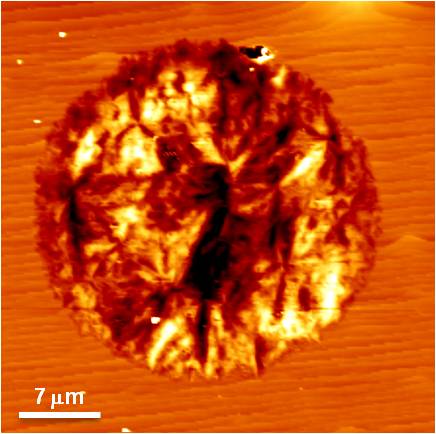2D materials: Transition metal halides and graphene
In addition to molecular materials, our research activities also address the growth, structure, functionalization, patterning, and electronic properties of transition metal halides (TMH) and graphene using low-temperature scanning probe microscopy (STM / ncAFM) and spectroscopy techniques (tunneling / force spectroscopy) in ultra-high vacuum.
Recently, our research focused on the growth and patterning of transition metal halides on Au(111). Additionally, we investigated the structural and electronic properties of graphene functionalized both non-covalently and covalently using high-resolution scanning probe microscopy. This research includes studies on epitaxial graphene grown on metals and SiC(0001). By controlling the functionalization, we can modify the physical and chemical properties of graphene, and explore the interactions between molecules, metal clusters, and graphene. These research activities are part of the SFB 953 program.

AFM measurement in ambient condition of a free-standing graphene membrane on SiC(0001) [ACS NANO 2013] |
Selected publications:
- Intrinsically Patterned Two-Dimensional Transition Metal Halides
F. Xiang, N. Bisht, B. Da, M.S.G. Mohammed, Ch. Neiss, A. Görling, S. Maier
ACS Nano, 18, 29, 18870–18879 (2024) - Gateless patterning of epitaxial graphene by local intercalation
C. Sorger, S. Hertel, J. Jobst, C. Steiner, K. Meil, K. Ullmann, A. Albert, Y. Wang, M. Krieger, J. Ristein,
S. Maier, H. Weber
Nanotechnology 26, 025302 (2015) - Graphene-Templated Growth of Pd Nanoclusters
K. Gotterbarm. C. Steiner, C. Bronnbauer, U. Bauer, H.-P. Steinrück, S. Maier*, Ch. Papp*
J. Phys. Chem. C, 118, 29, 15934–15939 (2014) - Robust Graphene Membranes in a Silicon Carbide Frame
D. Waldmann, B. Butz, S. Bauer, J.M. Englert, J. Jobst, K. Ullmann, F. Fromm, M. Ammon, M. Enzelberger, A. Hirsch, S. Maier, P. Schmuki, Th. Seyller, E. Spiecker, and H.B. Weber
ACS Nano, 7 (5), 4441–4448 (2013)